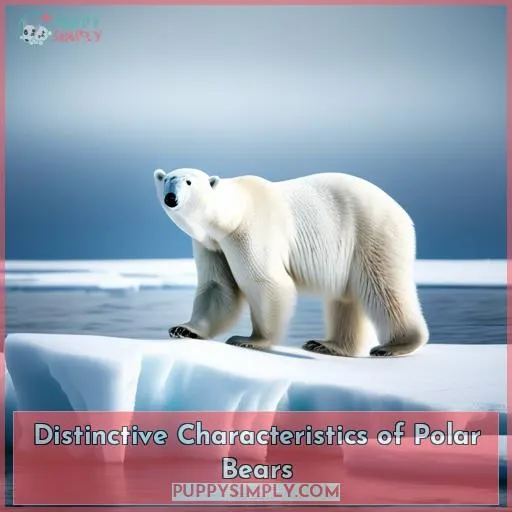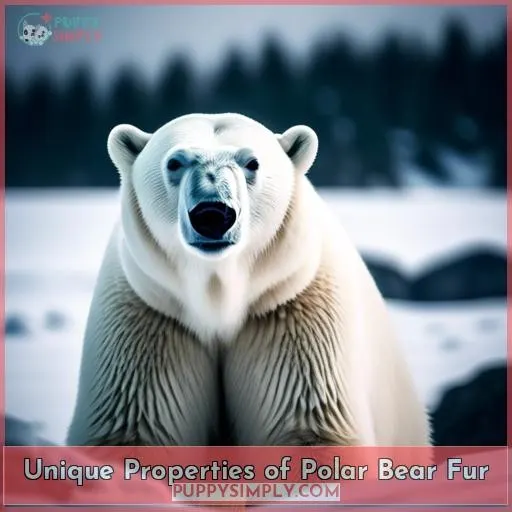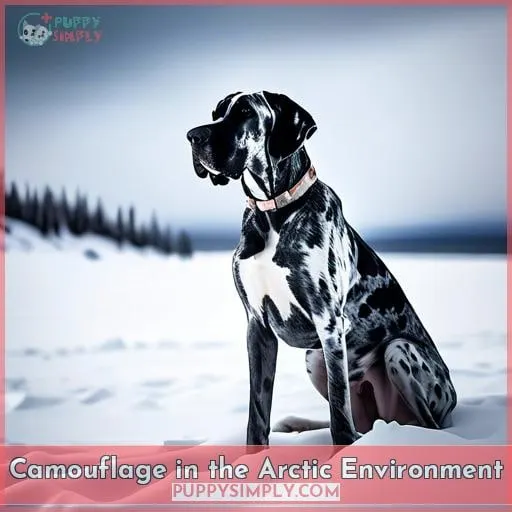This site is supported by our readers. We may earn a commission, at no cost to you, if you purchase through links.
 Unravel the mystery of bananas and canine consumption.
Unravel the mystery of bananas and canine consumption.
Discover the nutritional secrets concealed within these yellow wonders and how they can enhance your furry friend’s well-being.
From providing an energy boost to aiding digestion, bananas offer a natural treat that nourishes and delights.
Dive into the details and learn how to safely integrate this tropical goodness into your dog’s diet, ensuring a healthy and joyful canine experience.
Table Of Contents
- Key Takeaways
- Distinctive Characteristics of Polar Bears
- Evolutionary Adaptations
- Unique Properties of Polar Bear Fur
- Thermoregulation
- Camouflage in the Arctic Environment
- Ultraviolet Protection
- Sensory Functions
- Environmental Vulnerabilities
- Winter Covering and Arctic Ecosystems
- Conservation and Future Outlook
- Nutritional Benefits of Bananas for Dogs
- Safe Snacking Guidelines
- Potential Health Advantages
- Incorporating Bananas Into a Dog’s Diet
- Precautions and Considerations
- Frequently Asked Questions (FAQs)
- What are the potential health benefits of bananas for dogs beyond providing energy and dietary fiber?
- Are there any specific breeds or sizes of dogs that should avoid eating bananas due to potential health risks?
- How can I tell if my dog is allergic to bananas or if they are experiencing an adverse reaction after consuming them?
- What other fruits and vegetables are safe for dogs to eat as occasional treats, and what are their recommended serving sizes?
- If I want to give my dog a banana as a treat, how should I prepare it to ensure it is safe and easy for them to eat?
- Conclusion
Key Takeaways
- Bananas offer nutritional benefits for dogs, including potassium for heart and muscle function, an energy boost from carbohydrates, fiber for digestion, and vitamins and minerals for overall health.
- Safe snacking guidelines include serving small portions occasionally, pureeing or freezing for different textures, and monitoring digestion to avoid adverse reactions.
- Potential health advantages of bananas for dogs include supporting heart and muscle function, aiding digestion, providing a nutrient-rich snack, and boosting energy levels.
- Incorporate bananas into a dog’s diet through snacks, smoothies, homemade treats, DIY dog biscuits, or as a flavor enhancer for kibble.
Distinctive Characteristics of Polar Bears
So, you’re curious about polar bears, the magnificent rulers of the Arctic?
Let’s embark on a fascinating journey into their world, where we’ll uncover:
- Their impressive size
- Their apex predator status
- Their remarkable physical adaptations to this icy realm
Large Size and Role as Apex Predators
Since they’re the largest living bear species and apex predators in the Arctic, you’ll find polar bears ruling their icy domain, shaping the ecosystem’s dynamics.
Their sheer size and prowess make them the top dogs of the polar wilderness, commanding respect and awe.
It’s not just their size that grants them dominance; their skills as hunters and their ability to thrive in extreme conditions make them the ultimate Arctic predators.
Physical Adaptations to the Arctic
Venturing into the Arctic’s unforgiving terrain, you’ll encounter polar bears, whose bodies are specially adapted to survive in this frigid landscape.
Their thick layers of blubber, dense fur, and broad paws provide insulation and buoyancy, allowing them to navigate icy waters and withstand extreme temperatures.
Evolutionary changes have gifted them with keen senses, enabling them to detect prey and navigate the vast, frozen expanse.
Their fur structure, a marvel of nature, aids in camouflage and thermoregulation, while climate impact and sensory enhancements further shape their survival strategies in this ever-changing Arctic realm.
Evolutionary Adaptations
Let’s start with how polar bears evolved to excel in their Arctic habitat.
Over thousands of years, they’ve developed unique adaptations that set them apart from brown bears, their closest relatives.
Their thick fur coat, insulating layer of blubber, and oversized paws are just a few examples of how they’ve become perfectly suited to survive in the frigid Arctic.
Adaptation to Arctic Environment
Polar bear’s evolutionary journey’s adaptation to the Arctic’s harsh conditions showcases remarkable resilience and survival instinct.
Their genetic lineage diverged from brown bears, presenting unique adaptations that allow them to thrive in this realm.
They’ve evolved a thick layer of fat, a dense undercoat, and webbed paws for traversing landscapes and waters.
These adaptations highlight their ability to survive in an environment that’s unforgiving to most.
Genetic Divergence From Brown Bears
You’ll learn about the genetic variations that distinguish polar bears from their brown bear cousins in this section on evolutionary adaptations.
Genetic drift and the firm grip of natural selection in the Arctic have driven these changes.
Hybridization’s impact has been minimal, allowing polar bears to carve out a unique ecological niche.
Behavioral variances, like their adept swimming and hunting tactics, further set them apart.
These adaptation mechanisms have gifted polar bears with a genetic makeup that’s uniquely suited to their frigid realm.
Unique Properties of Polar Bear Fur
Let’s examine the fascinating adaptations of polar bear fur:
- Its structural coloration and lack of pigment allow it to camouflage in its icy habitat.
- The keratin and hollow hair shafts provide insulation and buoyancy in water.
- The transparency and light scattering properties of the fur enhance its insulating abilities.
Structural Coloration and Lack of Pigment
Discover the fascinating relationship between polar bear fur’s structural coloration and the absence of pigment.
This unique adaptation creates optical illusions, making them appear white despite lacking pigment.
It’s not just a fashion statement; this evolutionary advantage helps them blend seamlessly into their snowy habitat, aiding in hunting and avoiding predators.
Delve into the biological significance of this remarkable adaptation, understanding its profound impact on their survival and the delicate balance of the Arctic ecosystem.
Keratin and Hollow Hair Shafts
Examining the polar bear’s fur reveals keratin-based, hollow hair shafts, much like your beloved canine’s.
Keratin’s robust structure ensures hair maintenance, while the hollow design offers insulation and buoyancy.
These attributes highlight the profound connection between polar bears and their Arctic home, inspiring us to reflect on the nutritional needs of our canine companions.
Transparency and Light Scattering
With their transparent fur shafts that scatter light, you’re getting an up-close look at how polar bears stay warm.
See, the hollow hairs, transparent to the skin, act as tiny light pipes, guiding sunlight deep into their fur.
This ingenious adaptation helps them absorb more solar radiation, keeping them cozy even in the iciest Arctic conditions.
It’s a beautiful example of nature’s engineering, a testament to the polar bear’s remarkable adaptation to its frigid home.
Thermoregulation
Let’s shift gears and explore how polar bears master the art of thermoregulation in their icy realm. Despite the harsh Arctic conditions, they’ve evolved remarkable strategies to maintain their internal warmth.
Picture this: polar bears possess a thick layer of fur and blubber that work together like a well-insulated jacket. The fur acts as a barrier, trapping air and creating thermal gradients, while the blubber layer provides insulation efficiency, preventing heat loss.
As seasons change, polar bears adjust their insulation strategies. During warmer months, they shed some of their fur, allowing for better heat dissipation. When temperatures plummet, they grow a thicker coat, maximizing their insulation capabilities.
Beyond physical adaptations, polar bears have metabolic adaptations and behavioral responses that contribute to thermoregulation. They can increase their metabolic rate to generate heat when needed, and they’ll often seek out sheltered areas or huddle together for warmth.
Camouflage in the Arctic Environment
How does a polar bear’s white fur aid in camouflage within its icy habitat? It’s like nature’s stealth suit!
The brilliant white fur acts as the ultimate Arctic camouflage, blending seamlessly with the snow and ice. This snowy disguise helps them stalk prey and evade predators, making them masters of their icy domain.
Polar bears’ white fur also offers UV protection, shielding their skin from the harsh Arctic sun, and it even plays a role in their sensory functions, helping them navigate their icy world.
Sadly, climate change threatens their habitat and survival, making their white fur both a blessing and a challenge in a rapidly changing world.
Ultraviolet Protection
In the vast, icy expanse of the Arctic, polar bears face not only the bitter cold but also the harsh glare of the sun.
Their fur, an Arctic sunscreen, provides them with remarkable UV protection.
Unlike the pigmented fur of other animals, polar bear fur is translucent, allowing light to penetrate and be absorbed by the black skin beneath.
This ingenious design, coupled with hollow hair shafts that reflect light, minimizes UV absorption and reduces the risk of sunburn and skin damage.
- Translucent Fur: Unlike pigmented fur, polar bear fur allows light to penetrate, minimizing UV absorption.
- Black Skin: The black skin beneath the translucent fur absorbs light, preventing it from reaching deeper tissues.
- Hollow Hair Shafts: These shafts reflect light away from the skin, further reducing UV exposure.
- Reduced Sunburn Risk: The combination of these adaptations shields polar bears from harmful UV radiation and sunburn.
Sensory Functions
Touching bananas initiates a sensory experience in your dog’s mouth and snout.
Its fur serves as a sensory tool, aiding in tactile perception. Nerve endings in the fur detect changes in texture and temperature, sending signals to the brain for processing. This sensory adaptation helps your dog navigate its environment, detect objects, and communicate with other animals.
The olfactory significance of fur can’t be overlooked. The fur’s surface area traps scent particles, allowing your dog to identify scents and track prey. Sensory evolution has equipped your dog with a keen sense of smell, and the fur plays a crucial role in enhancing this ability.
Environmental Vulnerabilities
You know how climate change affects the polar bears?
Their habitat, especially the sea ice they depend on, is melting.
This threatens their survival by making it harder to hunt and rest.
We must act now to protect these majestic creatures.
Impact of Climate Change on Habitat and Survival
A pressing concern lies in climate change’s impact on polar bear habitats and their survival.
Rising temperatures shrink their icy homes, forcing them to travel farther for food and mates.
Witnessing these majestic creatures struggle to adapt to a rapidly changing world is heartbreaking.
The time for action is now.
Let’s rally together to protect their Arctic havens and ensure their resilience for generations to come.
Threats to Natural Habitat and Sea Ice Dependency
You’ll discover how climate change threatens polar bears’ natural habitat and their dependency on sea ice for survival.
Melting ice floes and shrinking sea ice reduce their hunting grounds, forcing them to travel farther for food.
Habitat displacement disrupts their breeding and migration patterns, leaving them vulnerable and isolated.
Human activities like oil exploration and pollution further exacerbate these challenges, leaving polar bears clinging to the edges of their icy domain.
Winter Covering and Arctic Ecosystems
Your polar bear’s winter covering is no ordinary coat; it’s a masterpiece of Arctic adaptations.
Picture this: a thick, plush layer of fur, each hair hollow and transparent, creating a natural insulator. The lack of pigment grants it a unique see-through quality, allowing sunlight to penetrate and warm the bear’s skin.
Now, imagine yourself in the bear’s icy domain. Its fur becomes a chameleon, blending seamlessly with the snowy backdrop, aiding in stealthy hunts and evading predators.
But that’s not all; this remarkable coat also shields the bear from the sun’s harmful UV rays, preventing sunburn and skin damage.
But the Arctic’s beauty masks a harsh reality: climate change threatens this delicate ecosystem. As sea ice melts and habitats shrink, your polar bear’s winter haven is under siege. It’s a fight for survival, and every element of their adaptation, including their winter covering, plays a vital role.
Conservation and Future Outlook
Given the ecological significance of polar bears and their vulnerability to climate change, you’re compelled to prioritize their conservation to ensure their survival in the Arctic.
- Climate Resilience: Support research and initiatives aimed at understanding and mitigating the impact of climate change on polar bear habitats.
- Human Impact: Reduce human activities that contribute to climate change and habitat degradation, such as fossil fuel consumption and pollution.
- International Collaboration: Foster international cooperation and agreements to protect polar bears and their Arctic habitat.
- Conservation Strategies: Implement conservation strategies that focus on protecting key polar bear habitats, reducing human-bear conflict, and promoting sustainable tourism practices.
- Adaptation Measures: Explore and support adaptation measures that help polar bears cope with changing environmental conditions, such as providing access to alternative food sources.
Nutritional Benefits of Bananas for Dogs
Potassium’s muscle and nerve support,
Fiber’s digestion aid,
And vitamins and minerals’ immune system boost
Make bananas a snack that benefits your dog’s health
And brings joy to their taste buds.
Potassium and Energy Boost
With their rich potassium content, bananas offer you an instant energy boost for your active canine companion.
Dietary potassium plays a crucial role in maintaining a steady heartbeat, regulating blood pressure, and supporting proper muscle function.
Treat your furry friend to a banana snack, and watch them bound with renewed vigor, ready for their next adventure.
| Nutrient | Benefit |
|---|---|
| Potassium | Regulates heartbeat, blood pressure, muscle function |
| Carbohydrates | Quick energy source |
| Natural Sugars | Easily digestible energy boost |
Fiber and Digestion Aid
A banana’s fiber content can ease your dog’s digestion and promote a healthy digestive system.
The dietary fiber impact in bananas helps firm up stool, ease constipation, and prevent diarrhea, keeping your furry friend regular.
Fiber also aids in nutrient absorption, providing a more wholesome meal experience.
Moreover, bananas’ prebiotic properties can positively influence your dog’s gut microbiota, promoting a balanced and beneficial microbial community.
Vitamin and Mineral Source
Moreover, bananas are a good source of several vitamins and minerals, including potassium, magnesium, and vitamin C, which can help support your dog’s overall health.
Vitamin Variety: Bananas offer a range of essential vitamins, contributing to a balanced diet.
Mineral Mix: The mix of minerals in bananas, like potassium and magnesium, aids in nerve and muscle function.
Dietary Diversity: Adding bananas to your dog’s diet promotes dietary diversity, reducing the risk of nutrient deficiencies.
Safe Snacking Guidelines
To ensure your dog’s well-being, always offer bananas in moderation. Balance is key when feeding your canine companion this tropical treat.
Small dogs may only need a few slices, while larger breeds can handle a whole banana.
Consider your dog’s texture preferences and flavor variations when choosing how to serve bananas.
Keep in mind your dog’s digestive sensitivity. Start with a small amount and monitor their reaction. Training treats are a great way to administer bananas, but avoid overindulgence. Portion control is crucial to prevent digestive issues.
Guidelines:
- Small dogs: a few slices
- Large dogs: up to a whole banana
- Puree for smooth texture
- Freeze for a refreshing snack
Potential Health Advantages
Now that we’ve covered the safe snacking guidelines for bananas, let’s delve into the potential health advantages they offer our canine companions.
They’re a powerhouse of essential nutrients like potassium, which helps regulate their heart function and blood pressure. Plus, the high fiber content aids in digestion, preventing constipation and keeping their tummies happy.
Bananas are also a rich source of vitamins and minerals, including vitamins B6 and C, as well as magnesium and manganese. These nutrients play a crucial role in supporting your dog’s overall health and well-being.
And let’s not forget the energy boost they provide, making them a perfect treat for active dogs who love to explore and play.
However, it’s important to remember that moderation is key. Too many bananas can lead to tummy troubles, so stick to the recommended guidelines.
Also, watch out for banana allergies, though they’re rare. If you notice any signs of an allergic reaction, like skin irritation or vomiting, stop giving your dog bananas and consult your veterinarian.
Incorporating Bananas Into a Dog’s Diet
With the knowledge of bananas’ potential health advantages, you can now move on to exploring ways of safely integrating them into your dog’s meals.
Start by introducing a small piece of banana as a snack between meals. You can also whip up banana smoothies, freeze them in ice cube trays for refreshing treats, or bake them into homemade dog biscuits.
Mash a banana and mix it with kibble for a flavor boost. DIY dog biscuits with banana, peanut butter, and oats are a delightful and nutritious snack option.
Precautions and Considerations
When feeding bananas to your dog, moderation is key.
Steer clear of banana peels, as they pose a choking hazard.
Keep an eye out for any signs of allergies, such as skin irritation or digestive upset.
Moderate Consumption
When offering bananas in your dog’s diet, moderation is key to prevent potential digestive upset.
Stick to small portions as an occasional treat, not a daily staple.
Balanced intake is vital.
Consider your dog’s size and activity level to determine appropriate serving sizes.
A few slices once or twice a week can delight your furry friend without causing tummy troubles.
Avoid Banana Peels
Banana peels pose potential choking hazards and gastrointestinal distress, warranting vigilance. Peel bananas before serving and keep peels out of reach to prevent accidental ingestion.
Compost peels instead of discarding them, nurturing your garden while minimizing waste.
While some sources claim banana skins are edible, always err on the side of caution and remove them before sharing this tasty treat.
Monitor for Allergies
Because all dogs are different, watch your pet for any allergic reactions after they’ve had a bite of banana.
Common signs can include skin irritation, vomiting, or diarrhea.
If you spot these symptoms, stop giving your furry friend bananas and consult your vet.
Start with a small piece and monitor their reaction before offering more.
Frequently Asked Questions (FAQs)
What are the potential health benefits of bananas for dogs beyond providing energy and dietary fiber?
Bananas offer more than just energy and fiber.
They’re packed with potassium, which supports heart and muscle function, and vitamins like C and B6 that boost immunity and cognitive function.
A tasty treat that’s good for your furry friend!
Are there any specific breeds or sizes of dogs that should avoid eating bananas due to potential health risks?
Certain breeds, like Bulldogs and Pugs, may struggle with breathing if they eat too much banana.
Small dogs, in general, should avoid bananas due to choking hazards.
Always consult your vet before introducing new foods.
How can I tell if my dog is allergic to bananas or if they are experiencing an adverse reaction after consuming them?
Watch for signs of an allergic reaction like swelling, hives, or difficulty breathing.
If they’re vomiting, have diarrhea, or seem uncomfortable, bananas might not agree with them.
What other fruits and vegetables are safe for dogs to eat as occasional treats, and what are their recommended serving sizes?
Apples, blueberries, and carrots make tasty treats for your furry friend.
Offer them in moderation to prevent tummy troubles.
If I want to give my dog a banana as a treat, how should I prepare it to ensure it is safe and easy for them to eat?
Peel, slice, and freeze bananas.
This is a refreshing summer treat that’s easy on your dog’s tummy and a fun way to cool them down.
Conclusion
Dogs can relish bananas, a delightful and nutritious treat.
Bananas are a rich source of potassium, which replenishes energy levels and aids in muscle function.
The fiber content in bananas promotes healthy digestion.
The array of vitamins and minerals in bananas supports overall well-being.
Moderation is key, and always keep an eye out for any allergic reactions.
Incorporate bananas into your furry friend’s diet responsibly, and witness the positive impact on their health and happiness.
Bananas are truly a delightful and beneficial snack for your canine companion.





















